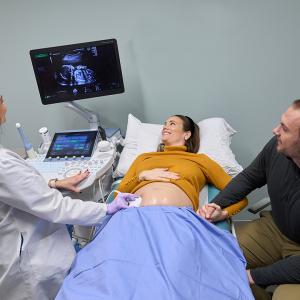
Rheumatology researchers at NYU Langone seek to identify and reduce the risk of adverse outcomes in patients with lupus across the age spectrum—from a pregnant woman and her fetus to seniors with lupus.
Photo: damircudic/Getty
Clinical trials led by NYU Langone Health rheumatologists are helping to identify and reduce the risk of adverse outcomes in patients with systemic lupus erythematosus (SLE) across the age spectrum. The studies demonstrate how expectant mothers can monitor for signs of congenital heart block (CHB) at home, how hydroxychloroquine (HCQ) can help lower the risk of this life-threatening condition in newborns, and how the same drug may be safely withdrawn in older patients who discontinue it because of ocular toxicity concerns. “We’re talking about rheumatology studies that are covering the human life span, from a pregnant woman and her fetus to seniors with lupus,” says Jill P. Buyon, MD, the Sir Deryck and Lady Va Maughan Professor of Rheumatology and director of the Division of Rheumatology and Lupus Center at NYU Langone. “It speaks to NYU Langone’s strong capability to lead multicenter trials in rheumatology.”
Hydroxychloroquine Significantly Reduces Risk of Congenital Heart Block
In roughly 1 out of every 15,000 live births, CHB can lower a newborn’s heart rate to a dangerous 50 beats per minute or less. Of the 80 percent of newborns with CHB who survive, nearly 3 in 4 will eventually require a pacemaker, and some will need a heart transplant.
Women with anti-Sjogren’s syndrome A/Ro (anti-SSA/Ro) antibodies are at particularly high risk (they can have SLE or Sjogren’s syndrome or be entirely asymptomatic), and studies have suggested that those who give birth to a child with CHB have a recurrence rate of 18 percent or more in subsequent births. A new open-label study led by NYU Langone researchers, however, has found that giving women HCQ (prescribed as Plaquenil®) early in pregnancy can more than halve the recurrence rate, to about 7.5 percent.
The extensive analysis, recently published in the Journal of the American College of Cardiology, suggests that HCQ can be a powerful preventive during high-risk pregnancies. “Our study shows hydroxychloroquine as the first safe and highly effective drug for preventing at-risk pregnant women from having another child with congenital heart block,” says lead author and rheumatologist Peter M. Izmirly, MD, associate professor of medicine at NYU Langone.
In the Prospective Open Label Preventive Approach to Congenital Heart Block with Hydroxychloroquine (PATCH) study, researchers enrolled 63 pregnant women from across the country who had anti-SSA/Ro antibodies and who had previously given birth to a child with CHB. The women were given 400 mg of HCQ daily before completion of 10 weeks of gestation, and then followed through their pregnancies and evaluated for any signs of CHB.
Of the 63 patients, the study identified 5 cases of CHB, including 4 in a subset of 54 patients who received no potentially confounding medications. The evaluations met the efficacy endpoint, with recurrence rates of 7.9 and 7.4 percent, respectively, or less than half of the historical 18 percent rate. Although subsequent analyses will be important for validating the results, Dr. Izmirly says data collected to date for all anti-SSA/Ro antibody–positive pregnant women seen at NYU Langone clinics support the significant decrease in CHB recurrence among those given HCQ.
“The implication now is that a woman who previously had a child with heart block might be prescribed hydroxychloroquine as a safe prophylaxis,” says Dr. Buyon, the study’s senior author. Given that many women are unaware of their anti-SSA/Ro antibody status until their child is diagnosed with CHB, the results also could bolster the case for expanding screening and for providing first-time pregnant women who test positive for the antibodies with HCQ as a preventive, she says.
Hydroxychloroquine Not Associated with Fetal QT Interval Abnormalities
As an extension of the PATCH study, the researchers investigated the potential for cardiac toxicity in the neonates of anti-SSA/Ro antibody–positive mothers taking HCQ. Past research had reassuringly suggested that such toxicity manifest as a dangerously lengthened QTc interval on electrocardiograms (ECGs) did not occur. But Dr. Buyon notes that most such studies relied on women’s self-reported adherence to HCQ despite well-documented adherence shortfalls.
The PATCH study overcame such bias by measuring HCQ levels during each trimester in maternal blood and cord blood and then comparing these levels with the newborn’s QTc intervals. Study collaborator Deborah Friedman, MD, a pediatric cardiologist at New York Medical College in Valhalla, evaluated the neonate ECGs and measured their QT intervals to detect any abnormalities.
Excluding those neonates diagnosed with heart block, the resulting analysis, published in the journal Circulation: Arrhythmia and Electrophysiology, showed no relationship between HCQ levels and the QTc interval. Of the 45 neonates included in the analysis, ECG measurements suggested that 5 did have a prolonged QT interval, with 3 deemed only marginally abnormal and 2 clearly abnormal. “We saw no negative clinical consequences in any of these cases, however,” Dr. Buyon says. “Based on our results, this study has helped to assure the safety of hydroxychloroquine during pregnancy.”
Despite the many challenges associated with the complicated and time-consuming trials, she and Dr. Izmirly say, NYU Langone has been able to draw upon its sizable patient cohorts and highly supportive collaborators to marshal its resources and collect vital information with immediate clinical applications.
Large At-Home Monitoring Trial Aims to Detect and Reverse Heart Block
NYU Langone researchers are leading a multisite study assessing the potential for an at-home fetal heart rate monitor to quickly detect CHB during pregnancy. The trial, Surveillance and Treatment to Prevent Fetal Atrioventricular Block Likely to Occur Quickly (STOP BLOQ), is being funded by the National Institute of Child Health and Development.
Among the study’s aims is to investigate whether the titer of maternal anti-SSA/Ro antibodies can be used for risk stratification. In addition, the team is assessing whether pregnant women can use home fetal heart rate monitoring to identify any abnormalities, and whether second-degree heart blocks discovered through the study can be reversed via rapid treatment with intravenous immunoglobulin (IVIG) and dexamethasone.
Dr. Buyon is co-leading the trial with Bettina Cuneo, MD, professor of pediatrics and obstetrics at the University of Colorado, in collaboration with Dr. Izmirly and a site team led by Colin K. Phoon, MD, associate professor of pediatrics and director of the Pediatric and Fetal Echocardiography Lab at NYU Langone. An initial pilot study of 300 patients led by Dr. Cuneo showed that pregnant women can be taught to listen for and identify abnormal fetal heart rates, paving the way for a planned follow-up with a larger cohort.
Researchers at NYU Langone will first measure the titer levels of 1,300 pregnant women with confirmed anti-SSA/Ro antibodies. “If the patient has a titer that meets or exceeds the threshold, we will consider her to be at greater risk for having a child with CHB, and she will then begin home monitoring to track the fetal heartbeat,” Dr. Buyon says. The researchers expect about 850 women will meet that titer cutoff, and about 30 fetuses will develop second-degree heart block.
During the monitoring phase, from 17 weeks through 25 weeks gestation, women with high-titer anti-SSA/Ro antibodies will self-monitor 3 times a day with an at-home Doppler device. These recordings will be sent to cloud storage via a phone app. If the mother perceives an abnormal rate or rhythm, an immediate alert is sent to the cardiology team for review. If the cardiologist agrees with the abnormality, an urgent echocardiogram will be done. If it confirms second-degree block, the mother will immediately receive IVIG and dexamethasone. The researchers hope that very rapid treatment of an incomplete block will reverse the condition injury and prevent permanent and complete third-degree block.
“This study has definite potential, particularly in times of COVID-19, to empower women to help identify a fetal heart problem early enough to make a difference,” Dr. Buyon says.
Seniors with SLE Not at Higher Flare Risk After Halting Hydroxychloroquine
Despite a broad consensus that HCQ is safe and efficacious for preventing SLE flares, as well as considerable evidence of its utility in preventing blood clotting and organ damage, more sensitive ophthalmology measurements have raised concerns about ocular toxicity associated with long-term use in seniors. A groundbreaking study by NYU Langone rheumatologists found that patients 55 years or older who withdrew from HCQ after long-term use were at low risk for disease flares, suggesting that the drug can be safely discontinued due to toxicity concerns or other reasons. The encouraging results of the retrospective study, published in Arthritis Research and Therapy, have garnered a planning grant from the National Institutes of Health for an expanded confirmatory trial of 330 patients who are at least 60 years old.
Dr. Izmirly, the study’s lead author, says a prospective randomized trial by Canadian researchers concluded that withdrawing HCQ after only a few years of administration in younger patients with SLE increased the risk of flares. But few researchers had explicitly examined the risks associated with stopping the drug in older patients after long-term use.
When patients were matched by age, gender, and race, Dr. Izmirly and colleagues showed that SLE flare rates were similarly low over a one-year follow-up period among older patients who either continued or discontinued HCQ after taking it for at least five years. The study included 26 patients who withdrew from the drug and 32 who continued taking it, and Dr. Izmirly cautions that the small study requires validation with a larger cohort. “We can’t say anything definitively, but it gives us some reassurance that patients whose lupus was inactive at the time and who stopped the drug due to eye toxicity have a pretty good chance of remaining inactive,” he says.
The planned follow-up study—a prospective, randomized trial—should provide firmer conclusions. “But there were no data previously,” Dr. Izmirly says. “At least now we can give our older patients some guidance on their risk of flaring if they withdraw from hydroxychloroquine.”

